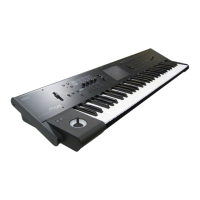SEQ P10: Pattern/RPPR 10–1: Pattern Edit
183
Control data in pattern recording
To record control data in a pattern, you should restore
the control data to its normal value within the pattern.
If you fail to restore the normal value, unnecessary
control data may remain in a “stuck” position when
you place the pattern in a song or use the RPPR
function to play the pattern. However, the following
control data will be automatically reset to the following
values when the song or RPPR function finishes
playing the pattern, or when playback is halted.
Pattern (Pattern Bank) [Preset, User]
Selects the type of pattern.
If Preset is selected, it will not be possible to record. You will
be able to select and execute the Copy Pattern, Bounce
Pattern, Put To Track, and Copy To Track menu commands.
Pattern Select [P000...671, U00...U99]
Selects a pattern.
User patterns can be renamed in the P10: Pattern/RPPR–
Pattern Name page.
(Tempo) [040.00...300.00, EXT]
Specifies the playback tempo of the pattern. For more
information, please see “ (Tempo)” on page 130.
Metronome [Only REC, REC & Play, Off]
Specifies whether the metronome will sound during
recording or playback. For more information, please see “0–
1–8c: Metronome Setup” on page 140.
Reso (Realtime REC Quantize Resolution)
[Hi, 3 … ]
Specifies how the timing of the data being recorded into the
pattern will be corrected. For more information, please see
“Reso (Realtime REC Quantize Resolution)” on page 131.
Remove Data [Off, On]
On (checked): Unwanted performance data can be removed
during pattern recording. The procedure is the same as
explained in Remove Data of Loop All Tracks. For more
information, please see “Remove Data” on page 139.
10–1c: USED IN SONG TRACK,
USED IN RPPR
USED IN SONG TRACK
This area indicates the pattern usage status for the patterns
selected for the track.
USED IN RPPR
This area indicates the RPPR in which the selected pattern is
used. The assigned key and the specified track are shown.
▼10–1: Menu Command
• 0: Memory Status ☞p.191
• 1: Exclusive Solo ☞p.73
•2: Step Recording (Loop Type) ☞p.206
•3: Event Edit ☞p.206
•4: Pattern Parameter ☞p.206
•5: Erase Pattern ☞p.206
•6: Copy Pattern ☞p.206
•7: Bounce Pattern ☞p.207
•8: Get From Track ☞p.207
•9: Put To Track ☞p.207
• 10: Copy To Track ☞p.208
• 11: Convert to Drum Trk Pattern ☞p.208
• 12: Load Drum Track Pattern ☞p.209
• 13: Erase Drum Track Pattern ☞p.209
• 14: FF/REW Speed ☞p.192
For more information, please see “Sequencer: Menu
Command” on page 191.
Controller Reset value
Modulation 1 (CC#01) 00 (zero)
Modulation 2 (CC#02) 00 (zero)
Expression (CC#11) 127 (max)
Ribbon controller (CC#16) 64 (center)
Damper switch (CC#64) 00 (zero)
Sostenuto switch (CC#66) 00 (zero)
Soft switch (CC#67) 00 (zero)
EG sustain level (CC#70) 64 (center)
Resonance level (CC#71) 64 (center)
EG release time (CC#72) 64 (center)
EG attack time (CC#73) 64 (center)
Low pass filter cutoff (CC#74) 64 (center)
EG decay time (CC#75) 64 (center)
LFO1 speed (CC#76) 64 (center)
LFO1 depth (pitch) (CC#77) 64 (center)
LFO1 delay (CC#78) 64 (center)
Filter EG intensity (CC#79) 64 (center)
SW1 modulation (CC#80) 00 (zero)
SW2 modulation (CC#81) 00 (zero)
Channel aftertouch 00 (zero)
Pitch bender 00 (zero)

